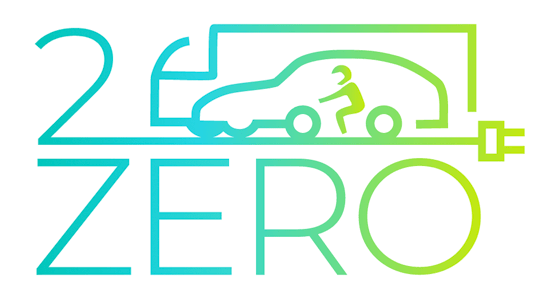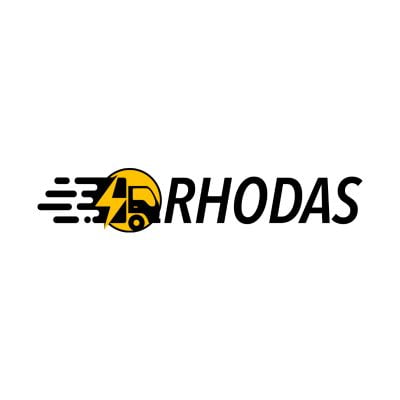e-DASH – Electricity Demand and Supply Harmonization for EVs (July 2014)

- Website: www.edash.eu
Overall Project Objective
The project “e-DASH” (Electricity Demand and Supply Harmonization for EVs) coordinated by Volkswagen aims at the design, development and validation of an innovative charging solution for fleets of Fully Electric Vehicles (FEVs) enabling sustainable FEV grid integration in the context of sometimes contradicting requirements like individual driver requests, availability of renewable energies, energy demand as well as low-voltage grid capacity. The project’s approach involves a fleet manager (OEM) who interacts with grid stakeholders, like Balancing Responsible Parties (BRPs), and provides best effort grid services through controlled charging of his FEV fleet. In order to do so, the flexibility of the fleet’s charging profile is offered through a brokering instance to respective grid stakeholders, who choose their favourable demand profile within the fleet’s nominated flexibility. Based on the grid stakeholder’s request, the fleet manager decomposes the requested demand profile from an aggregated fleet level to individual FEV charging schedules respecting decentralized local grid constraints. This new form of integrating FEVs in the energy network requires the development of intelligent hybrid charging concepts, in the sense of partly centralized vs. decentralized charging control. Such distributed control requires algorithms reducing the need for near real-time information exchange between all stakeholders to a minimum. This allows all participating stakeholders in the OEM and utility domains to create a new and currently unused potential within their value chains. The e-DASH FP7 project develops and validates this new approach, always considering and building upon existing as well as currently developing standards in the E-Mobility landscape (e.g. ISO/IEC 15118).
Project Structure
The project objectives are achieved by the development of “V2G (Vehicle-to-Grid) Front-End” interfaces in WP200, covering “FEV Charging (V2G Communication Interface)” and “FEV Support (V2OEM Back-End Interface)”. As part of WP300 the project proposes a “V2G Broker” for negotiating fleet demands with respective grid stakeholders and an “OEM Back-End” for decomposing aggregated fleet demand profiles to individual FEVs. Furthermore, “V2G Grid Compatibility” is addressed in WP400 with the “Demand Clearing House” and a dedicated “FEV Demand & Supply Management”. Thus e-DASH targets an intelligent infrastructure harmonization and delivers unique and innovative selling propositions for new V2G businesses and services. The vertical technology and innovation developments of WPs 200 to 400 are augmented by cross-cutting activities of WP500: “Auxiliaries and Demonstration”, covering “Data Protection & Privacy”, “ISO/IEC Standardization”, “Communication and Dissemination”, as well as “Testing and Validation on Sub-System-Level” leading to fully fledged “System Demonstration”. Based on the capacities of the grid infrastructure of ENDESA (Malaga) and RWE (Mühlheim/Ruhr), the demonstration will perform the project results with small fleets of FEVs from VW, Renault, Fiat and Mitsubishi.
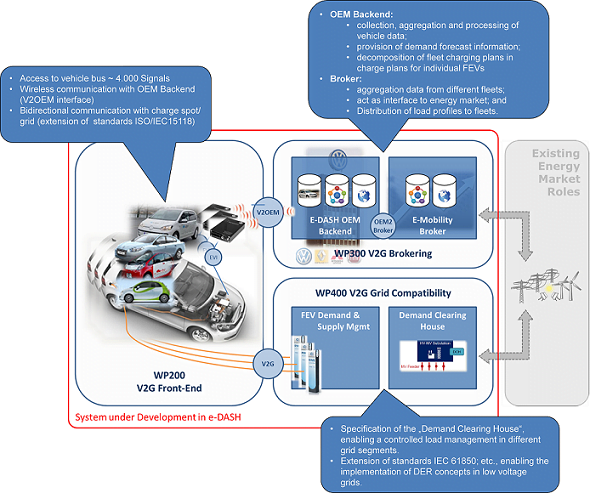

Figure 1 Overall e-DASH Concept
The e-DASH consortium includes 4 OEMs collaborating with 2 major European utilities and renowned research institutes to lay a strong footing for the proposed solution approach. In this regard it is worthwhile to mention that the OEMs involved in e-DASH have a market share of 40% for passenger cars in the EU.
State of the Project
The e-DASH consortium addresses a wide variety of topics that require different points of view regarding the interaction of FEVs with the grid and the energy market: Vehicle-to-Grid (V2G) communication protocols and norms, existing and expected electrical network architectures and their variability in different European countries, fleet management requirements, constraints caused by FEVs, emergence and properties of renewable energies, various business models of energy, mobility etc. In a first step a common knowledge was built to develop a holistic vision of the grid and e-mobility interactions.
It was intended to integrate as soon as possible a vision of the business model that would allow exploiting successfully the technical results of “e-DASH”. The first option was to position e-DASH as a mean to address the Control Reserve Business. The idea was to consider the fleet of FEVs as a Virtual Power Plant (VPP), which could help to regulate the overall electrical balance in a region or a country. However, thinking of the constraints and benefits of such a business model, it became soon clear that it is unrealistic to provide an independent balancing service to the grid with the exclusive use of FEVs. Firstly, the number of FEVs that are needed to make the case realistic was very high (hundreds of thousand vehicles). Secondly, the control reserve is addressed at the level of a country and there was no clear view how to scale up from a fleet at private parking lots with charge spots to a set of fleets in a town let alone to a set of fleets in a region and onwards to a large set of fleets (seen as a plant) in a country. In contrast, it was found that the main problem at hand with the introduction of renewable energies was the sustainability of regional distribution networks and that the best business opportunity is there.
WP200: V2G Front End
The V2G Front-End Interfaces are understood as key enablers for smart charging a fleet of FEVs as part of the e-DASH project proposition. Hence, a main topic under development in WP200 of e-DASH during the first two years has been the advancement of the Powerline Communication based interface between the FEV and the charge spot, the so-called “V2G Communication Interface”. Main partners in this WP are also members of the ISO/IEC 15118 Joint Working Group for a long time. They actively supported the continuous development of the standard as part of the e-DASH project by completing specification work and parallel prototyping. The consortium published their prototype implementations as part of an open source initiative (refer to http://openv2g.sourceforge.net). The complexity of the standard made it necessary to start an open source initiative in order to gain a common understanding between different stakeholders and to validate the specification work at an early point in time. In order to ensure long-term interoperability of the interface these actions were understood as crucial enablers.
The second major development in WP200 deals with the V2OEM FEV Support Interface, an extension of existing telematics interfaces of road vehicles for FEV charge control. In contrast to the V2G Communication Interface it is an over-the-air interface based on cellular radio networks. It defines a charge session independent communication channel to the FEV and used as part of the decomposition process of FEV charging profiles. The telematics protocol was harmonized with the specific requirements for legacy charging according to IEC 61851-1 as well as smart charging according to ISO/IEC 15118 from the very beginning. The specification work is finalized and first promising prototypes are available for legacy charging in real environments and for smart charging in laboratory environments, fully integrated with ISO/IEC 15118 prototypes.
WP300: E-Mobility Broker
The OEM Backend acts upon all FEVs within the fleet utilizing the V2OEM FEV Support Interface (WP200) and represents the mediator between the individual FEVs and the E-Mobility Broker. It consolidates all individual demand data from groups of FEVs building an overall demand profile for a fleet of spatially and temporally interrelated clusters of FEVs. Furthermore it offers an indication on flexibility for charging the fleet of FEVs to the E-Mobility Broker with the forecasting module.
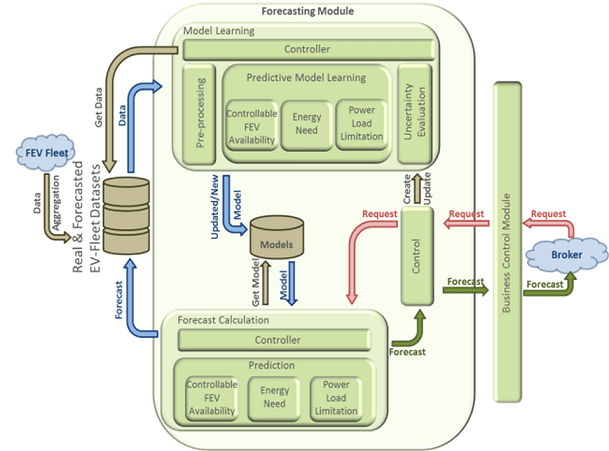

Figure 2 OEM Backend Forecasting Module
The underlying processes for the “OEM Back-End” are specified in the project. The specification respects the gathering and data mining processes for FEV fleet knowledge, day-ahead forecasts as well as intraday forecast updates and dynamic charging control of FEVs. Based upon the fully specified V2OEM FEV Support Interface as well as the OEM Back-End to E-Mobility Broker (OEM2Broker) Interface, the OEM Back-End can decompose aggregated charging profiles to individual charging profiles of each FEV.
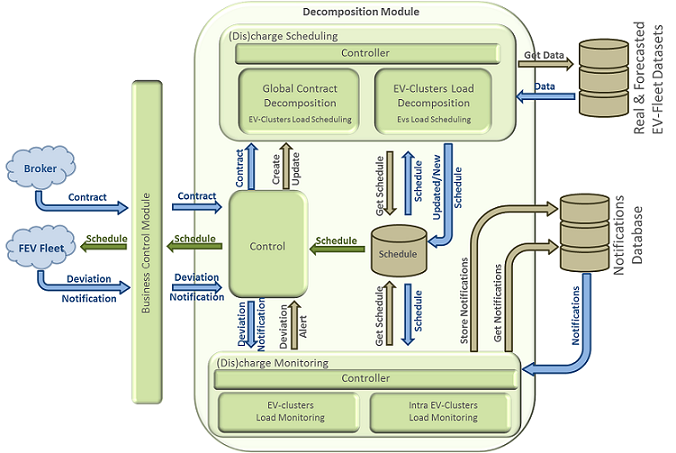

Figure 3 OEM Backend Decomposition Module
To build a first prototype the required hard- and software architecture for the realisation of the OEM Back-End were defined and relevant parameters, which have to be considered by the OEM-Backend for management purposes, were studied.
Next to the OEM Back-end the specifications and definitions of the E-Mobility Broker (EMB) concept were carried out. Based on the results of a requirement analysis, a comprehensive solution concept for the EMB communication infrastructure and services was developed. An interface directly interacting with the Balancing Responsible Parties (BRPs) was specified. It offers means for aggregating demand and supply profiles of several FEV fleets and may be extended to include other types of Distributed Energy Resources in the future. Furthermore it manages the negotiation of contracts between energy markets and FEV fleet managers, including the handling of day-ahead and intraday load profiles for diverse fleets. The EMB system architecture, its functional entities and the associated service platform are specified and implementation of the Broker Platform has started.
WP400: V2G Grid Compatibility
Smart Grid approaches in several European countries (focusing on Spain, France, and Germany) and the requirements for integration of FEVs into the grid were derived based upon current standardization activities. The definition of core services to be accomplished by a Demand Clearing House (DCH) and FEV Demand & Supply Management (DSM) to achieve seamless integration of FEV fleets next to other demands and supplies into the distribution grid is finalized. The definition of smart charging scenarios and related services required to support grid integration of FEV fleets and ensure the necessary Quality of Service (QoS) is defined. Respective functional architectures and specifications of DCH are close to finalization. The definition of DSM’s software architecture and functional specification based on dynamic grid constraints to be managed by FEV-DSM, as well as the negotiated charge scheduling process between FEVs and charge spots is furthermore finished. For the latter, an in-depth review of scheduling techniques for FEV charging and a study based on state of the art for resource allocation algorithms was prepared.
The ICT architecture of grid stakeholders in the e-DASH project currently builds upon state of the art approaches like IEC 61850 for grid automation and Open Charge Point Protocol (OCPP) for the communication between charge spots and operator back-ends. In case of IEC 61850 an E-Mobility Object Model was defined and prototyped within the project in order to establish a plugged-in FEV as a Distributed Energy Resource in the Grid. During the prototyping of these approaches several improvements and advancements of current technical specifications were identified and respective recommendations were proposed to both OCPP and IEC working groups.
Project Partners
- Volkswagen (DE) – Coordinator
- Renault (FR)
- Centro Ricerche Fiat (IT)
- RWE (DE)
- ENDESA (ES)
- CEA List (FR)
- IBM (DE)
- ERPC GmbH (DE)
- Atos Origin (ES)
- TRIALOG (FR)
- TU Dortmund – Communication Networks Institute (DE)
- Knowledge Inside (FR)
- Eurisco (DK)
- ATB Bremen (DE)
- Broadbit (SK)
- Mitsubishi (JP)
